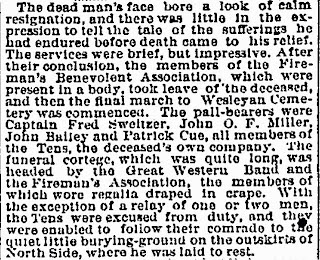Update: Memorial LODD List
The Line of Duty Death memorial list is a relatively recent creation. Prior to the compilation of the list, members lost in service to the fire department were noted in the fire departments annual reports. Often more detail was recorded by local news sources. Until the recent past the department did not maintain a list of these names. The research and efforts of several members of the fire department were joined together to generate the LODD list as it stands today. These members spent countless hours pouring through newspaper microfilm and old department reports to gather as complete a list as possible. From time to time names of firemen past that made the ultimate sacrifice are still uncovered. This update represents one such situation.
The company diary pictured below was being utilized to research The Gay Fire. This fire was the deadliest single event in history for members of the CFD. Five firemen were killed that day on December 11, 1880. The diary records the time of the event and the names of those firefighters lost. It then goes on to note that "Eve Stewart died the same night from injuries from Box 21 on the 8 December while putting the Engine No10 to work." A later entry for December 14, 1880 further indicates that "Eve Stewert on this afternoon was buried." The LODD list will soon be updated to reflect the addition of Stewart's name.
Ephriam Stewart
Engine Co.10
Stoker/Former Captain
LODD - Dec 12, 1880 from injuries received at the scene of a fire at the Gould, Pearce & Co
(3rd & Culvert Streets) December 8, 1880.
Stewart was struck in the groin by a brass connection while separating hose from a hydrant.
This is the original article in the Cincinnati Enquirer that notified the public of the death of Stewart:
Cincinnati Enquirer: Among the Ruins, The Scene of the Horrible Holocaust
Article Date 13 Dec 1880
This Cincinnati Enquirer article conveyed the story of the Stewart and his life and death. Stewart was said to have been the third man sworn into service of the paid fire department. At the time of his death he was the oldest member of the CFD.
Engine Co.19 Diary - Bill Houston Collection
The entry for December 11, 1880 records the deadly results of the Gay Fire and notes the passing of firefighter Eve Stewert. On December 14th it is also indicated that he was laid to rest.
Engine Co.19 Diary - Bill Houston Collection
The Cincinnati vital statistics card indicating the death of Ephrem Stewart. Stewart is listed as being white and widowed. He is 50 years of age. The cause of death is listed as injuries to the abdomen (Peritonitis) and he is listed as being buried in the Wesleyan Cemetery.
Cincinnati Death Index Card - UC Rare Books Library
View the current
of CFD members lost in service











